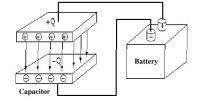We know that when two bodies are rubbed together electric charge is produced. Again when a charged body is brought in contact with another neutral body the later is charged. When the neutral body is placed not in contact with the charged body but close to the charged body, the former becomes charged. This happens due to induction. The process of charging a neutral body by bringing it very near to the charged body is called electric induction. With a simple experiment the electric induction has been explained below.

Experiment: A dry glass rod is rubbed with silk. One end of the rod is brought very near to the neutral conductor rod AB keeping the other end of the glass rod in hand [Fig: (a)]. As a result the free electrons of the conductor are attracted by the positive charges of the glass rod and move the end A. Therefore, the end B falls in short of electrons and is charged positively. The end A is charged negatively. With a charge collector [a small metal sheet attached to a nonconductor handle] if some charges are collected from end B and their nature is detected with the help of an electroscope then the above discussion will be proved.
Here no new charge is produced. Due to the presence of the charges glass rod equal amount of opposite charges are separated only and move towards the end o the conductor. As long as the glass rod is present near the conductor AB, the opposite charges are separated and remain at the end of the conductor.
In the above experiment the positive charges in the glass rod which has created induction in the conductor AB is called inducing charge. The charges which are accumulated in the conductor A are called induced charge.











